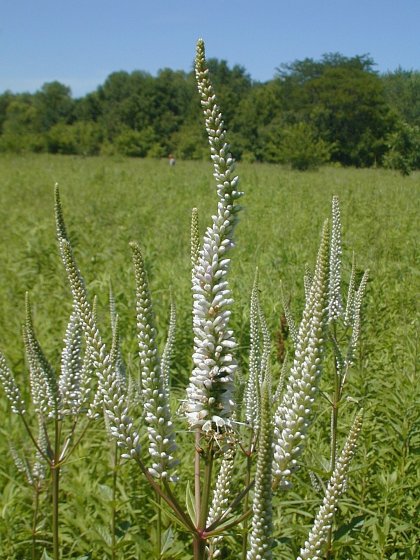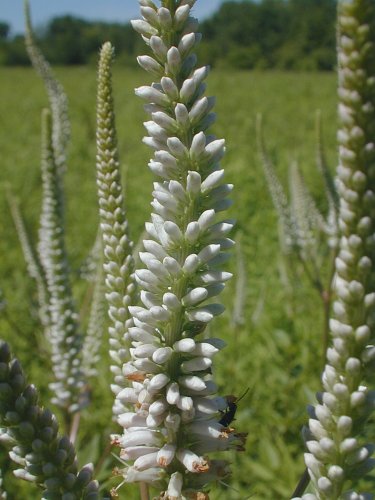Description: This perennial plant is up to 5' tall and unbranched, except near the inflorescence. The central stem is round and smooth. Scattered along this stem are 3-7 whorled leaves. These leaves are up to 6" long and 1½" across with serrated margins. They are ovate to narrowly ovate, and are either sessile or have short petioles. At the apex of the plant are several slender spikes of white flowers up to 8" long, resembling a candelabra. The narrow tubular flowers are about ¼" long, from which 2 yellow or brown stamens are exerted. These flowers are crowded together all around each spike, blooming from the bottom up. They have no scent.

The blooming
period usually occurs from early to mid-summer, and lasts about a
month. The tiny seeds can be carried several feet away from the mother
plant by the wind. The root system consists of a central taproot and
some rhizomes, which enable vegetative reproduction.
Cultivation:
The preference is full or partial sun, and moist to average conditions.
Growth is best in rich loamy soil, although some sand or clay is
tolerated. The leaves may turn yellowish green in bright sunlight or
during a drought, otherwise they normally appear healthy and are not
often bothered by disease. This plant has a tendency to flop over on
slopes.

Range &
Habitat:
The native Culver's Root occurs throughout Illinois, except a few
south-central
counties (see Distribution
Map). Although widely distributed, it is only occasionally
seen. Culver's root occurs in moist to mesic black soil prairies, sand
prairies, openings and edges of woodlands, thickets, savannas, and
swampy meadows along rivers and ditches. This plant is not often seen
in highly disturbed habitats.
Faunal Associations:
The most common visitors to the flowers are long-tongued and
short-tongued bees, which collect pollen or suck nectar. This includes
honeybees, bumblebees, Mason bees, Green Metallic bees, Masked bees,
and others. Other kinds of insect visitors include Sphecid wasps,
butterflies, moths, and Syrphid flies. The latter include species that
feed on pollen only and are non-pollinating. Culver's Root doesn't
appear to be bothered by leaf-chewing insects or mammalian herbivores
to the same extent as other plants. The seeds are too tiny to be of
much interest to birds.

Photographic
Location:
The photographs were taken at Meadowbrook Park in Urbana, Illinois.
Comments:
While in bloom, this plant has an elegant appearance, although the
pretty white flowers rapidly turn brown. Its common name refers to the
medicinal usage of the bitter root, which has purgative properties. The
surname 'Culver' probably refers to a pioneer physician who advocated
the use of this plant for the treatment of various ailments.